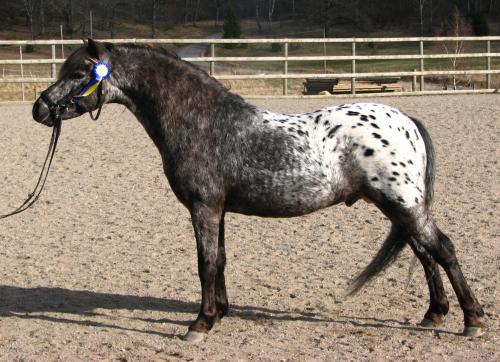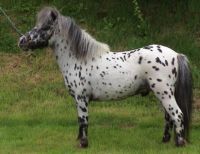|
Home Horse Breeds | First Posted: Aug 1, 2009 May 13, 2020 | |
British Spotted Pony 
Physical Description "General Character: A quality pony with adequate bone and substance, hardy and active with real pony character of miniature, riding or cob type up to and including 14.2 hh. Breed Characteristics: All ponies must display some or all of the following: White sclera around the eye. Mottled skin - this part-dark, part-pink skin is usually most evident around the genitals, lips, muzzle, eyes and inside the ears. Striped hooves...Leopard: Spots of any color on a white or lightly colored background. Near Leopard is very similar but the pony will usually have a darker head, neck and legs with the remainder of its body being similar to that of the Leopard. Few Spot Leopard: White base color with only a few spots. Strong characteristics often accompanied by varnish marks (groupings of dark hairs within an area - usually nose, check bones, stifle, gaskin and knee). Snowflake: white spots on a dark base coat. Blanket: An area of white over the hips and hindquarters with or without spots. Any base color. The blanket can extend over the entire back and shoulders. The latter must display strong breed characteristics. Mottled pattern: The coat is most often irregularly ticked with white, having also large or small roan spots, their outlines rather blurred. Sometimes also a coat looking like an ordinary roan but in which dark blots (varnish marks) appear. Solid color: is a pony bred from spotted parents but which does not display the spotted coat pattern. Interestingly, some ponies born solid color can and very often do develop spots as they get older. Piebald and skewbald markings of any kind are not eligible. Breeding to greys is discouraged as this dilutes the color and can introduce the greying (fading) gene. Solid colors are eligible for a separate register but must be of proven spotted breeding and preferably show some breed characteristics. The Inheritance Of The Spotted Coat Pattern is not completely understood and it is difficult to predict the markings of any unborn foal even from the same mating's carried out year from year. All spotted ponies (except genuine genetic Fewspots) are heterozygous and carry a solid color gene and a spotted gene. Consequently, even if both parents are loudly marked, they can still both throw their solid colored gene into the mating and the subsequent foal may then be born solid colored (no spots). Theoretically, from four mating's between the same spotted stallion and mare, you have a 25% chance of breeding a Fewspot, a 50% chance of breeding a spotted of some kind and a 25% chance of breeding a solid colored foal. The only exception to this is if one of the parents is a "genuine" Fewspot as both of their genes are spotted so their foal will almost certainly inherit a spotted coat pattern. Head: Full of quality and true pony character. Big bold eyes, set well apart. Ears should be well placed, small, neat and in proportion to the head. Prominent pen nostrils. Clean well defined throat. A coarse head and roman nose is discouraged. Neck: Should have good length and be well carried. Moderately lean in mares but inclined to be more cresty in stallions. Slightly heavier neck is allowable in the cob type. Shoulders: Good strong, sloping and well laid back. Withers should be well defined but not 'knifey'. Forelegs: Should be square and true. Not tied-in at the elbow. Long strong forearms with well developed knee. Short flat bone below the knee. Pasterns of proportionate length and slope. Well shaped dense hooves. The cob type should have a greater abundance of bone without coarseness and a moderate quantity of fine feather when in the rough. Hindquarters: Lengthy, strong, well muscled, not ragged or dropping with well set on tail. Hind Legs: Well let down hocks, large flat clean bone, prominent points. The hock not to be set behind a line from the point of quarter to fetlock joint. No sickle or cow hocks. Pasterns to be of proportionate length and slope. Hooves well shaped and dense.
Action: Low, straight, from the shoulder. Free flowing. Hocks well flexed with straight action coming well under the body. The cob type may show more knee action."
Breed Characteristics - British Spotted Pony History Spotted horses and ponies have been known to exist since prehistoric times - they appear in cave paintings in France dating back around 20,000 years and have also featured in Egyptian pictures dating from 1400 BC. "The British Spotted Pony is an endearing creature recognized for his unusual coat marking and renowned for his wonderful temperament. He makes an ideal and very versatile child's riding pony and when outgrown by the children, will happily adapt to becoming a superb - and eye catching - driving pony. He was at one time feral in the British Isles and his spotted coat pattern was his natural camouflage as he roamed the heaths and forests of ancient Britain. Stone Age man painted pictures of him on his cave walls and he also appeared in many illustrated manuscripts and drawings down through the ages. During Roman times, some of the mounts of the more important Officers were spotted horses of great elegance and from old paintings and documents, we have learned that many of the fine horses sent as gifts between the Royal Families of Europe were spotted.
After the last War, there was a great awakening of interest in spotted equines many of which were exported to Australia, America, Canada and Europe, so in 1947 a Society called the British Spotted Horse and Pony Society was formed to keep a register of them. With so many having left our shores during the 1960s and 1970s the British Spotted Pony became relatively rare and so in 1976, the Society split with the ponies of 14.2hh and under being looked after by the BRITISH SPOTTED PONY SOCIETY, while the bigger ones went under the wing of the BRITISH APPALOOSA SOCIETY." Breed History - British Spotted Pony Some Interesting Notes: Spotted ponies featured in 18th and 19th century English Artists paintings, such as John Wootton's "Lady Conway's Spanish Jennet," now in possession of Lord Hertford of Ragley Hall. Charles II had a strangely marked grey with red on his rump named 'Bloody Buttocks.' In a fifteenth century manuscript of the chronicles of Sir John Froissart, there is an illustration of a little chestnut spotted cob. For More Information:
British Spotted Pony Society |